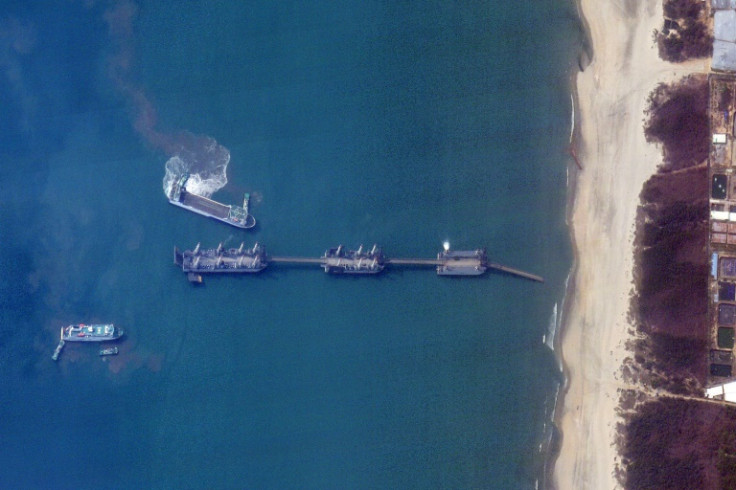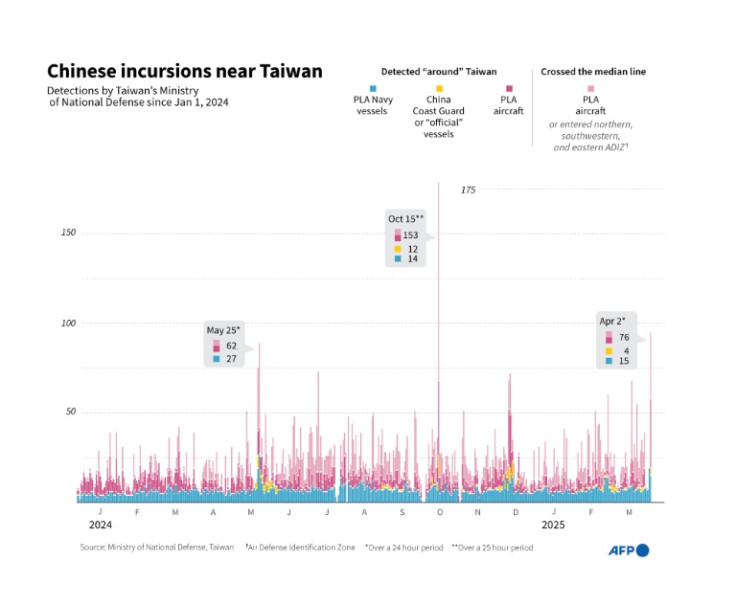China Floats Battle Barges In Taiwan Invasion Plans

Vast new Chinese barges spotted off the country's south coast could be used to land heavy equipment and thousands of personnel in a possible invasion of Taiwan, defence experts say.
Beijing this week launched what it called "punishing" drills around Taiwan, sending jets and warships in a rehearsal for a blockade and assault on the self-ruled island.
And a memo from US Naval War College has revealed another potential weapon in Beijing's arsenal -- barges that can connect via extendable ramps to form an 820-metre-long (half-mile-long) pier from deep waters to land.
With retractable legs that can push into the sea floor, the Naval War College said they could create a platform for personnel and "hundreds of vehicles" an hour to land on Taiwan, which China claims as its own territory.
"These barges are clearly meant to facilitate amphibious invasion against Taiwan," Wen-Ti Sung, a nonresident fellow at the Atlantic Council's Global China Hub, told AFP.
Wargaming of a potential Chinese invasion of Taiwan long assumed that Beijing's People's Liberation Army (PLA) would have been forced to rely on small amphibious landing vessels to get ashore.
Only a handful of Taiwan's beaches are suitable for large-scale amphibious landings -- giving Taipei a critical edge in the defence of the island.
"These barges may enable Chinese forces to make landings even on the more challenging terrains of the Taiwanese coastline," Sung said.
This, he added, "gives the Chinese military a greater selection of potential landing spots, and spreads Taiwanese defences thin".
Satellite images from Planet Labs PBC obtained by AFP show the system deployed in the waters off Zhanjiang city of Guangdong, southern China, at the end of March.
In a programme on state TV last month discussing the barges, military commentator Wei Dongxu touted their ability to transport large numbers of heavy equipment onto an island "while keeping their feet dry".
"Once the naval and air forces effectively control the air and sea, then this... barge will appear," he said.
"It can be said that it is a sign of victory."
And another three barges, dubbed Shuiqiao ("water bridge" in Chinese) by analysts, are under construction in southern China, the US Naval War College said.
"They embody the seriousness with which China under President Xi Jinping is pursuing absorption of Taiwan by any means possible," Andrew Erickson, professor at the US Naval War College's China Maritime Studies Institute, told AFP.
"China... would not waste resources on such a specialized, dedicated system if it were not bore-sighted on taking Taiwan by threat, or use, of force."
China could harness its world-leading shipbuilding industry to rapidly build many more barges at affordable cost, Erickson said.
Beijing has ramped up military pressure on Taiwan in recent years and held multiple large-scale exercises around the island that are often described as rehearsals for a blockade and seizure of the territory.
US officials say President Xi has ordered his military to be ready for an invasion of Taiwan by 2027.
And during this week's drills, Taiwan's defence ministry said it had detected 21 warships, 71 aircraft and four coast guard vessels around the island on Tuesday.
China's Shandong aircraft carrier also took part.
The drills, held less than a month after Taiwanese President Lai Ching-te called China a "foreign hostile force", saw Beijing practice striking "key energy sites" and ports, Beijing's military said.
But despite the bravado from Beijing, defeating well-prepared Taiwanese defenders and performing a successful invasion of the island still poses major challenges to China's modernising military.
And the barges are still no panacea for the logistical woes that will plague any future invasion.
The barges "appear vulnerable to attacks from land, air, and sea", the US Naval War College said.
"There are reasons why these capabilities aren't commonly touted as particularly viable," said Rorry Daniels, managing director of the Asia Society Policy Institute.
"They're... hard to hide, hard to defend, slow to move."
"You need air superiority for them to work and it's not clear to me that Beijing could establish air superiority over Taiwan."
US Naval War College's Erickson said they "cannot hope to survive in isolation".
Though still appearing to be in a trial phase of their deployment, the barges could be aimed at sending a message to Taiwan's leaders.
Beijing is saying "'We are actively problem-solving the issues that we see with a full-scale invasion of Taiwan,'" said Daniels.
"'And you should be worried about that.'"


© Copyright AFP 2025. All rights reserved.





















